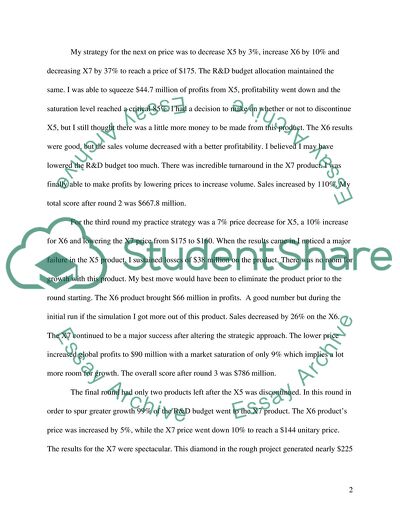
- Home
- Free Samples
- Premium Essays
- Editing Services
- Extra Tools
- Essay Writing Help
- About Us
- Studentshare
- Subjects
- Miscellaneous
- PDA Slim Part 3
PDA Slim Part 3 - Essay Example

- Subject: Miscellaneous
- Type: Essay
- Level: Ph.D.
- Pages: 4 (1000 words)
- Downloads: 0
- Author: marlene56
Extract of sample "PDA Slim Part 3"
The X5 price was decreased by 5%. The price strategy for X7 is to increase the price markup from 20% to 40% to see if it helps the results. The price of X6 in the first round will have a markup of 15% instead of the 10% previously used. The results for X5 showed a sales growth of 47%, a market saturation of 53% and a profit margin increase of 5%. So far at this point I believed that lowering the rate of growth for this product was the best course of action. It worked so far, but I noticed that last time the saturation levels were similar and the overall sales growth were much better.
The X6 product had good results, the number as far as profit margins were much better, but the sales volume decreased.. The X7 were bad. My total losses for this product grew to negative $18 million and there was only a 1% in market penetration. I knew was seriously wrong. My premise of increasing price to gain profitability was incorrect. The number that gave me the proof was the unitary sales decline of 40% this round. I had to reversed my strategy now in order to decrease the price of the X7.
My overall score after the first round was $489.5 million. My strategy for the next on price was to decrease X5 by 3%, increase X6 by 10% and decreasing X7 by 37% to reach a price of $175. The R&D budget allocation maintained the same. I was able to squeeze $44.7 million of profits from X5, profitability went down and the saturation level reached a critical 85%. I had a decision to make on whether or not to discontinue X5, but I still thought there was a little more money to be made from this product.
The X6 results were good, but the sales volume decreased with a better profitability. I believed I may have lowered the R&D budget too much. There was incredible turnaround in the X7 product. I was finally able to make profits by lowering prices to increase
...Download file to see next pages Read More
- TERMS & CONDITIONS
- PRIVACY POLICY
- COOKIES POLICY